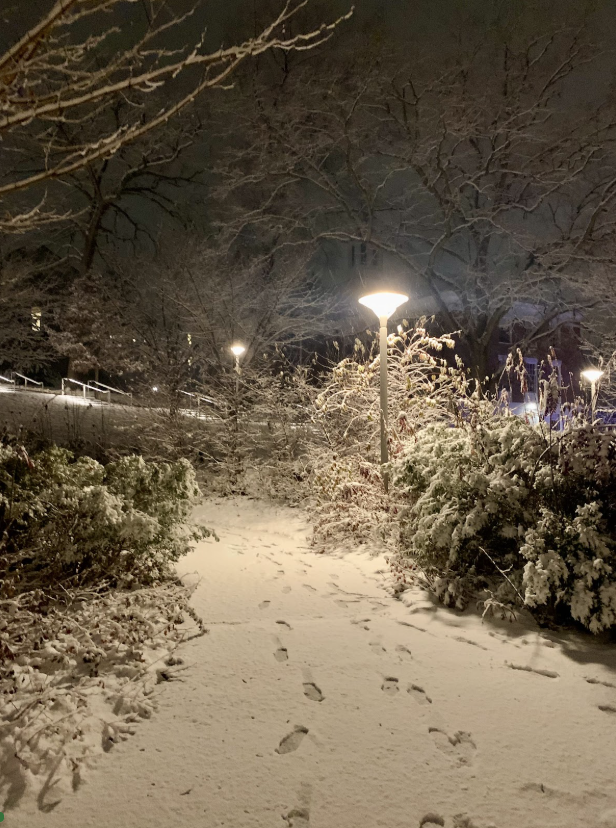Life at Amherst in 2021: A Reflection on the Loss of Student Spaces
Small pieces of snow, carried by the wind, sail across the First-Year Quad and collide with red bricks. In many ways, it is a typical winter in Amherst. The college has entered its second full semester during the Covid-19 pandemic, but it is clear to everyone on campus how different life is compared to before.
Whole buildings that used to brim with student activity are now unused. Campus no longer stirs with packs of eager students on their way to class. These spaces, whose original uses are lost to time, interest me as a student who has lived on campus both before and after the start of the pandemic. As a community and institution, Amherst is changing, and thinking about the loss of our most important spaces has helped me process this change.
I grew up listening to stories about my dad’s college days. His favorite moments were in the dining hall, meeting up with friends (and strangers too), mingling and eating for hours.
While such stories may not have been passed down to every Amherst student, these collective images and narratives in media representations of college inevitably inform how students interact with the idea of college life.
That place my dad loved to spend time in, the dining hall, feels like a thing of the past on this semester’s campus. At Amherst, Valentine Dining Hall, universally known by students as “Val,” is no longer what it once was. While the building is still frequently used by students who pick up three meals a day in a buffet-style line and by students who live in Val as a residence hall, the dining space is otherwise empty. The spaces where students used to eat, mingle and study for hours on end are filled instead by stacked chairs and tables.
I spoke to a sophomore about her favorite space in the dining hall, the balcony-like upstairs space with guardrails overlooking the lower seating areas. “I miss being able to go up there and always, no matter what time it was, running into someone who I would be so excited to see. I don’t tend to run into people like this anymore because we don’t overlap in the same way. I miss how cozy it was and that it was really a bonding space.”
Val was a place where we could eat with friends easily and spontaneously. I miss walking into Val, looking around the spaces and finding my friends in the same spots they usually were. I liked being able to choose where to sit and who to eat with. There was a sense of freedom attached to being able to come and go as one pleases.
Now, students have to rigorously plan in order to make meals social. It’s difficult to run into someone and make a plan to eat, all in the food pickup line. Of course, students have people they can text or knock on their door. But, while this can be both social and flexible, it just isn’t the same.
Not all of the spaces lost to Covid exemplify the pristine, collegiate buildings shown in Amherst’s brochures and campus tours. The biggest absence that students may currently feel is the loss of party spaces. According to the administration’s community safety guidelines, students cannot gather in groups larger than 10 people and must wear masks and maintain social distance. Before Covid, students gathered, drank and danced in specific party dorms, like those on the Triangle. It was an experience that students connected to being at college, or at least discovering what it meant for them to be at Amherst.
I’m not a partier. It wasn’t something I did very much in high school, but during my first year in college, I still pushed myself to experience the party scene at Amherst because I wanted to expand my social boundaries.
So, like many first-years used to do every weekend, I would file into Jenkins Dormitory, one of the quintessential party spaces at Amherst that is now the site for isolation housing, where students packed inside the small common room spaces. One student I spoke to fondly recalled the “sticky floor and the smell of beer,” as memories lost to the past.
“It was a place where you would run into people you coincidentally knew and like to see but don’t run into in other places,” she continued. And I miss that space, where you can run into people you haven’t seen in a while.” Like Val, the party spaces at Amherst facilitated a spontaneity that has been lost to Covid rules and regulations.
Of course, not all students envision the loss of these spaces as I do. But certainly, these shared spaces are tied to many students’ ideas of what Amherst is. These spaces are places for students to relate to each other, to bond over. When I talk to my friends about our first year at Amherst, we focus on these spaces as reference points for what life used to be like. It’s partially why I wanted to write this article. Amherst, of course, is more than an academic institution to those who end up devoting four years of their lives to its campus.
Some of the student body’s most beloved spaces are still open, like the Science Center, Frost Library, Beneski Museum of Natural History and the Mead Art Museum. Students are able to access these spaces freely, albeit with masks and social distancing. But I find that in a conceptual context, these spaces fundamentally differ from the lost spaces. The students I have spoken with on this topic both touch upon the joy of seeing someone in an organic, unplanned way; this is an aspect of social life that may be irreproducible during the pandemic, without such spaces as Val and party spaces.
As Covid has shifted campus life from common social spaces into atomized single dorm rooms, the current student body has a new conception of what Amherst is. I spoke to a first-year who said that Amherst is unique in that, “it’s [currently] entirely possible to exist here without interacting with anyone else.”
To those who have not lived on Amherst’s Covid campus, it might be hard to imagine what life is like here. The school publishes plenty of information about its number of Covid cases or the state of regulations. But, as anyone living on campus knows, these features are not what constitute life as a student. We go about our days alternating between Zoom class, picking up food, going to get tested, doing school work and hanging out with friends. It is an isolating life for many, especially for those who were not able to establish a support system during normal times.
For example, the Class of 2024 has faced collective isolation at an unparalleled degree. They had a fully online orientation, few in-person social events and a campus that has been under lockdown for the entire time that they have known it. These days, the college experience at Amherst only vaguely resembles the brochures.
For better or worse, students now bond over newer experiences than before the pandemic. And of course, life will eventually return to some version of normal, like the ground thawing into spring. But in order to move into the post-Covid world, Amherst, both as an institution and a community, has to acknowledge that the social needs of the student body may not be fulfilled until spaces lost to the pandemic can be recovered.




Comments ()